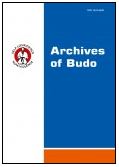2020, Volume 16
Isokinetic assessment of knee joint muscles in shotokan karate kata athletes
Anna Lisowska1, Michał Murawa1, Małgorzata Ogurkowska1
1Department of Biomechanics, Poznan University of Physical Education, Poznan, Poland
Author for correspondence: Anna Lisowska; Department of Biomechanics, Poznan University of Physical Education, Poznan, Poland; email: ania.lisowska90@gmail.com
Full text
Abstract
Background and Study Aim: Due to the observed phenomenon of knee joint pain in kata athletes, isokinetic assessment of hamstrings and quadriceps of shotokan karate kata athletes was performed and the results were compared to non-karate controls. The aim of the study was the question of whether under the influence of prolonged karate training there is an imbalance between the flexors and extensors of the knee joint and between the right and left lower limbs
Material and Methods: the participants were 15 kata athletes (aged 25.9 ±6.9) with a minimum of 12 years of training experience and 15 physically active students (aged 22.6 ±3.8). Biodex System 3 PRO, measuring shaft at 60∙s−1 and 180∙s−1 was used in the study.
Results: Comparison of mean value of the H:Q ratio for the right knee at 60°∙s−1 and left at 180°∙s−1 showed that the values obtained by karate athletes were higher (p≤0.05). There were no significant differences in bilateral movement of the knees between the karate and control groups. Mean values of the H:Q ratio and BD did not show any irregularities. It was demonstrated that quadriceps BD increased along with the training experience of kata athletes.
Conclusions: The results of the study showed correct proportions between knee joint flexors and extensors and no bilateral deficit was found. It should be assumed that pain in lower limb joints, especially knee joints in karate athletes does not result from flexing and extending movements, but rather from the ground reaction forces during dynamic transitions. It is necessary to measure the forces generated during the transitions in zenkutsu dachi, kokutsu dachi and kiba dachi.
Key words: hamstrings, quadriceps, martial art, biomechanics, H:Q ratio, bilateral deficit




